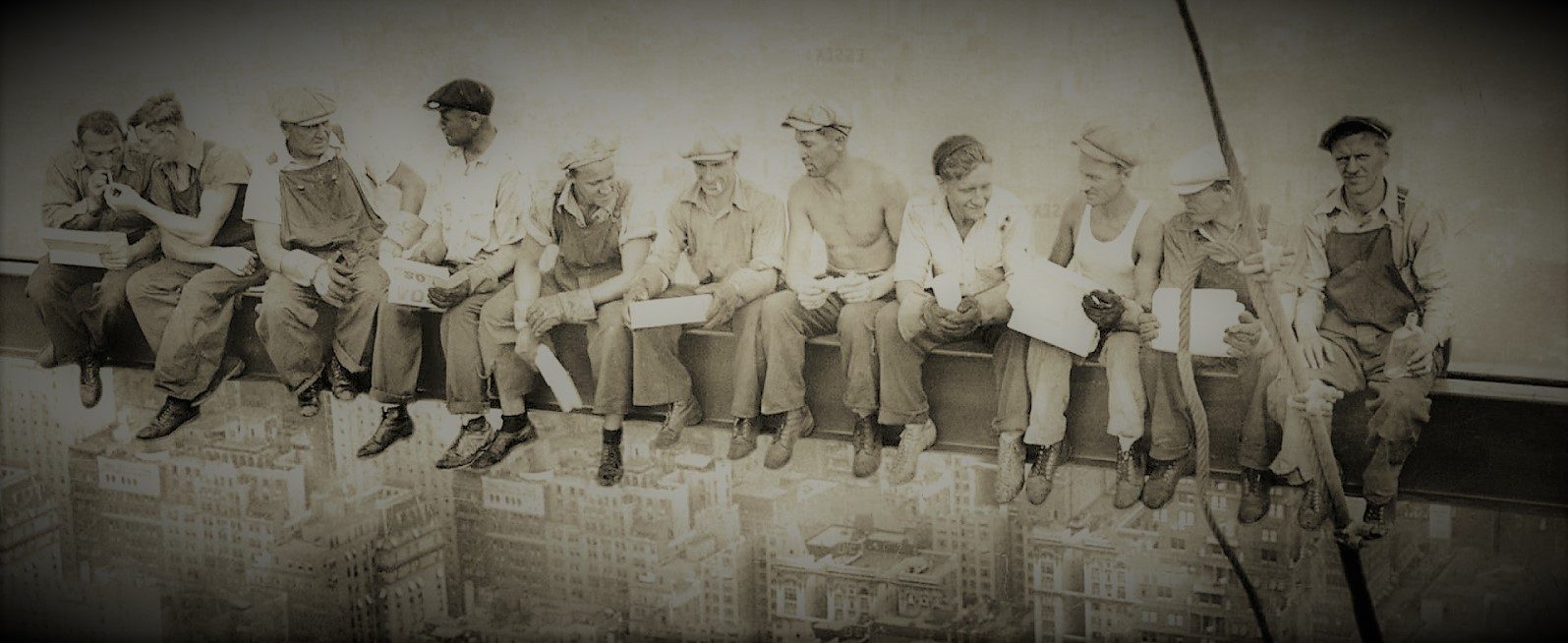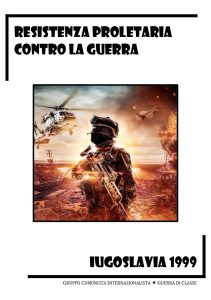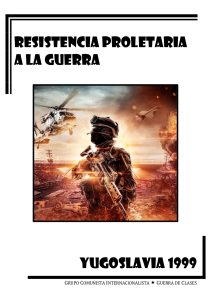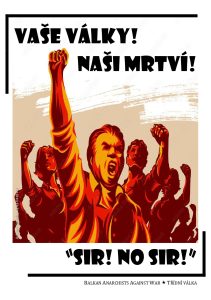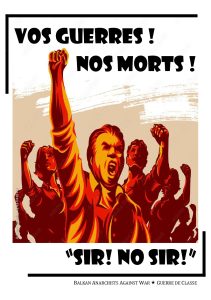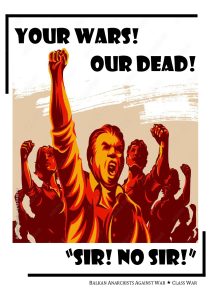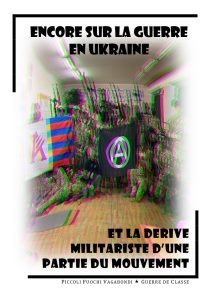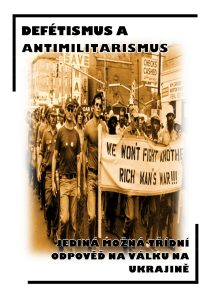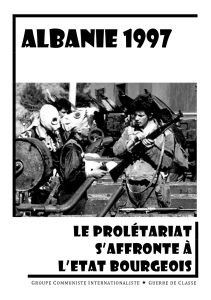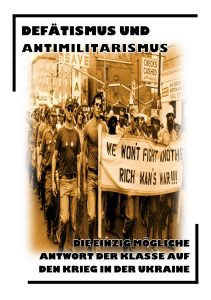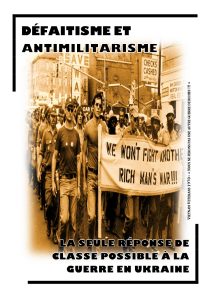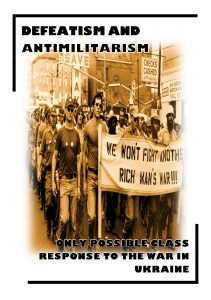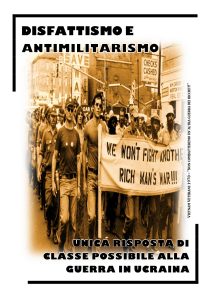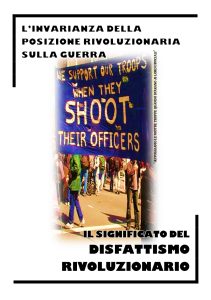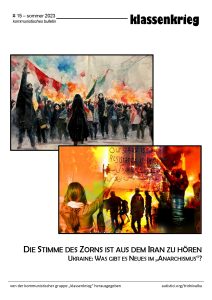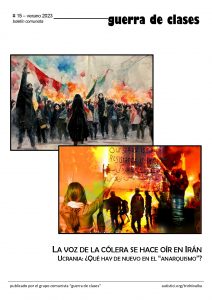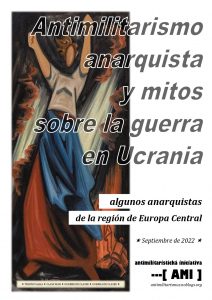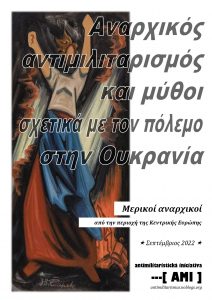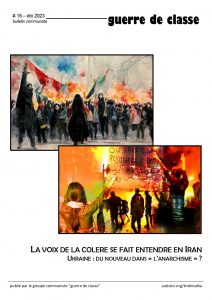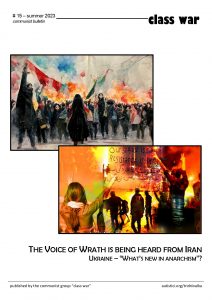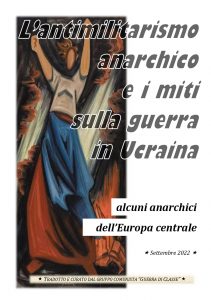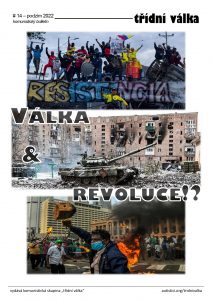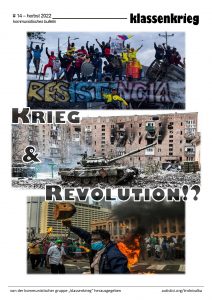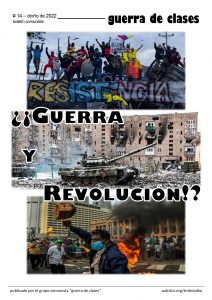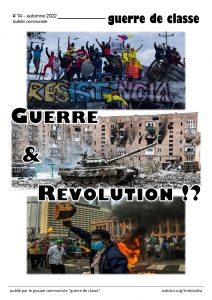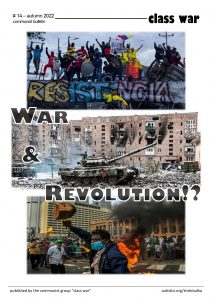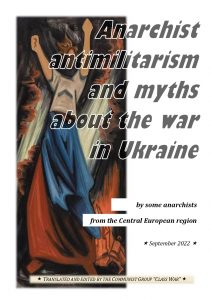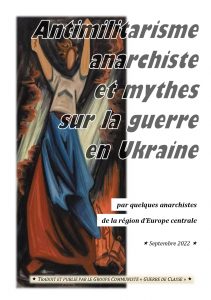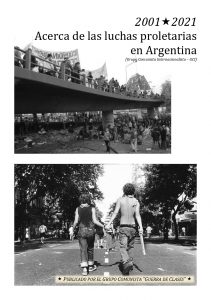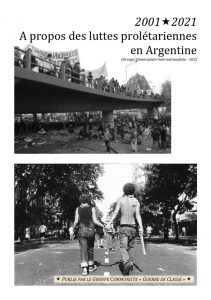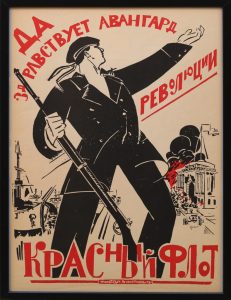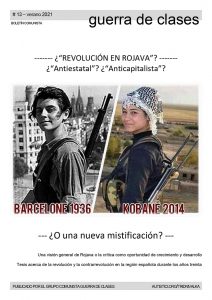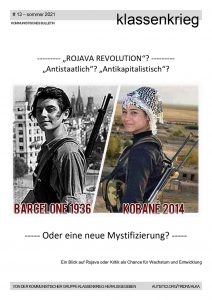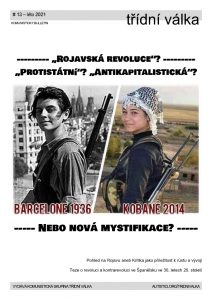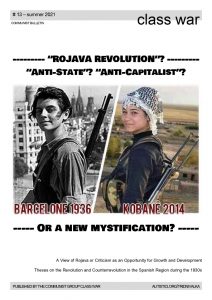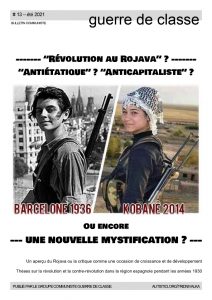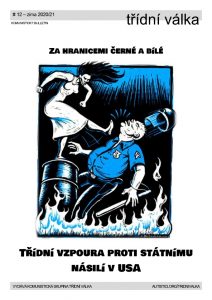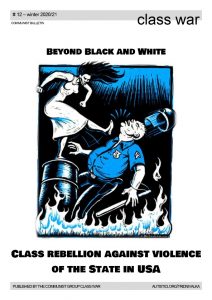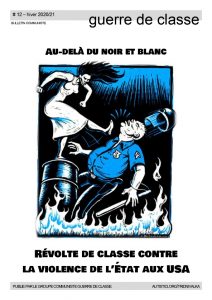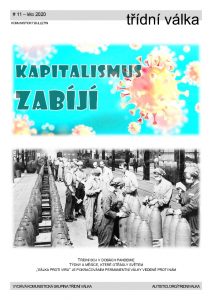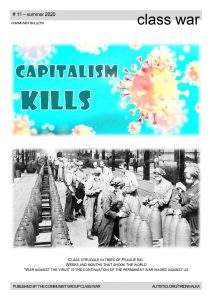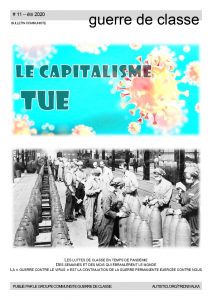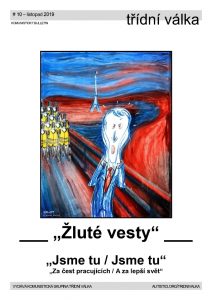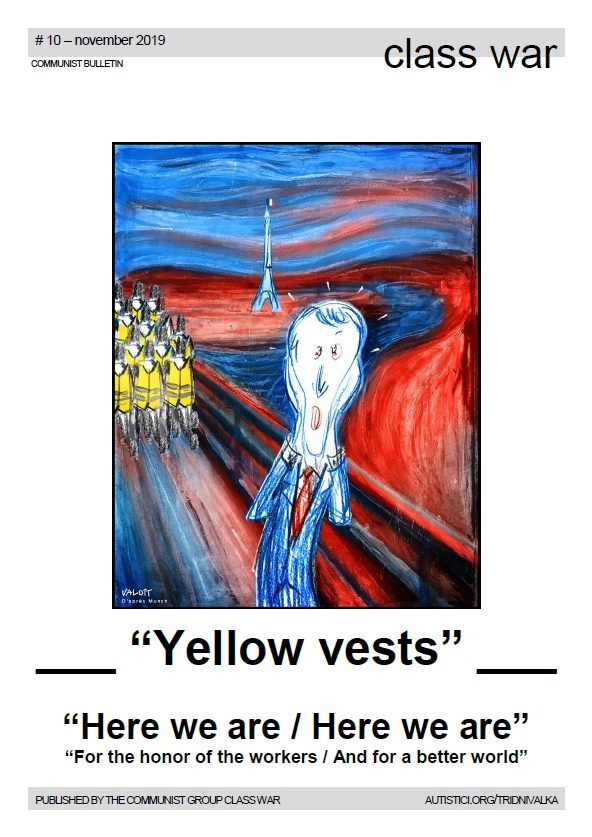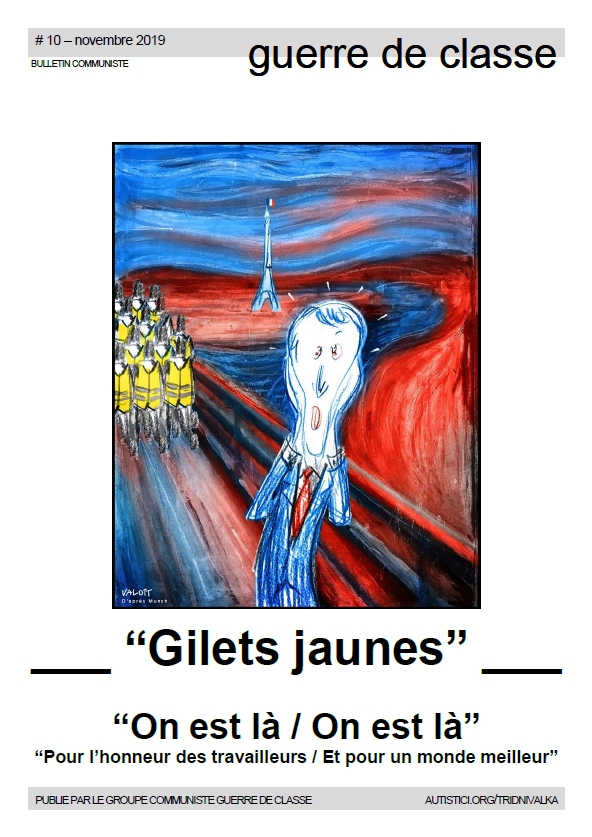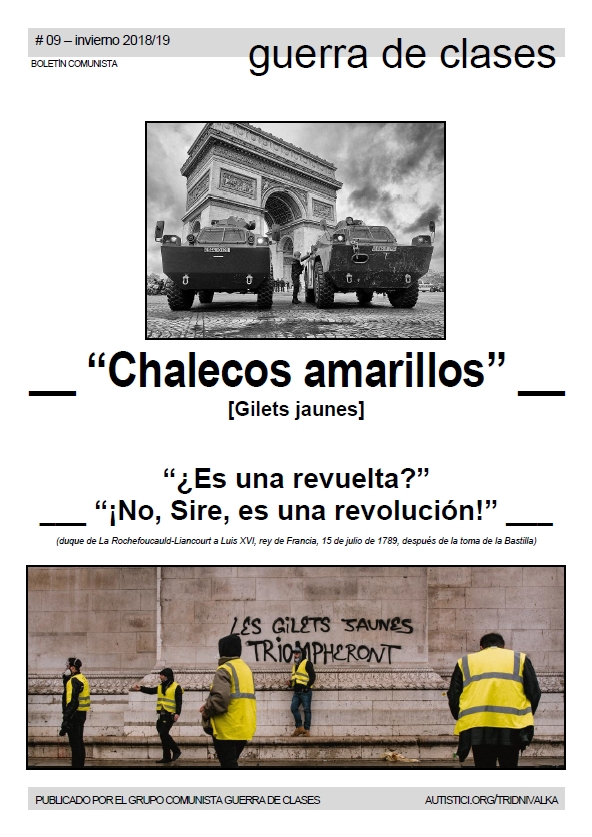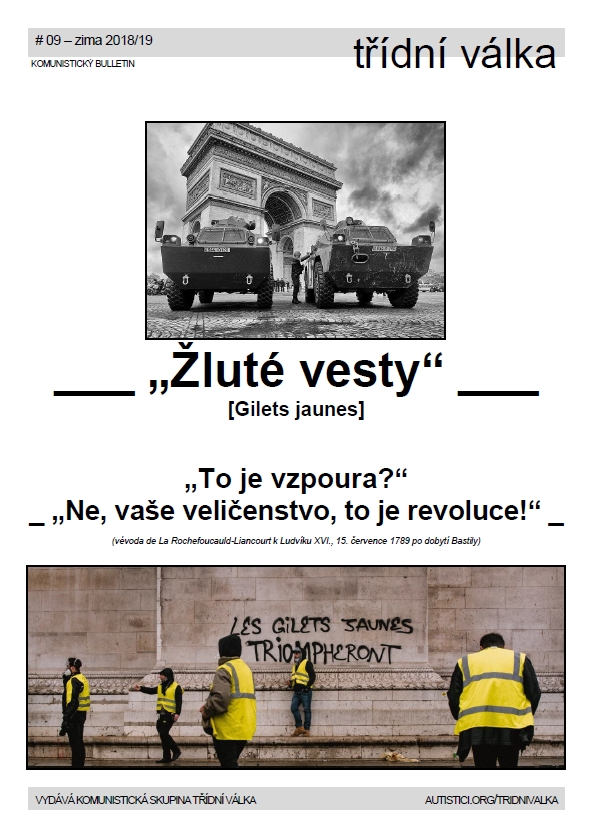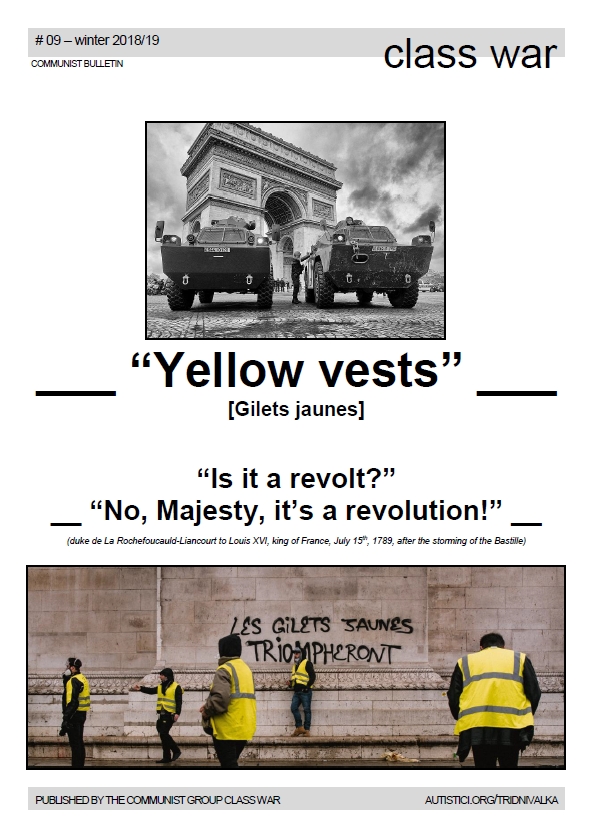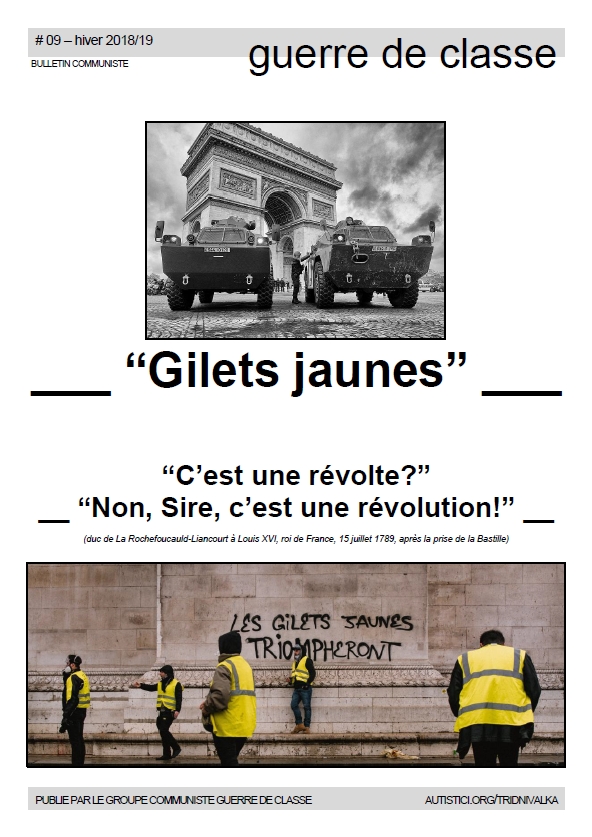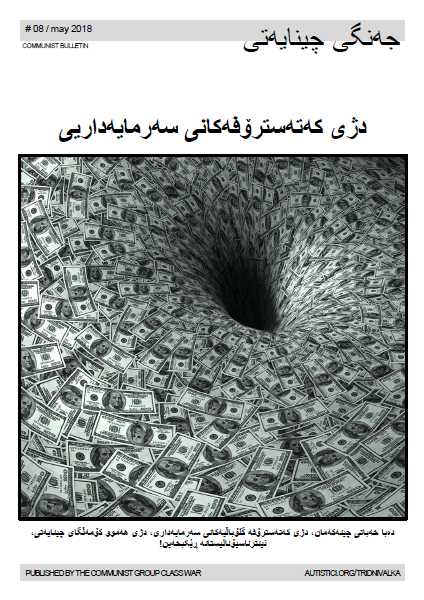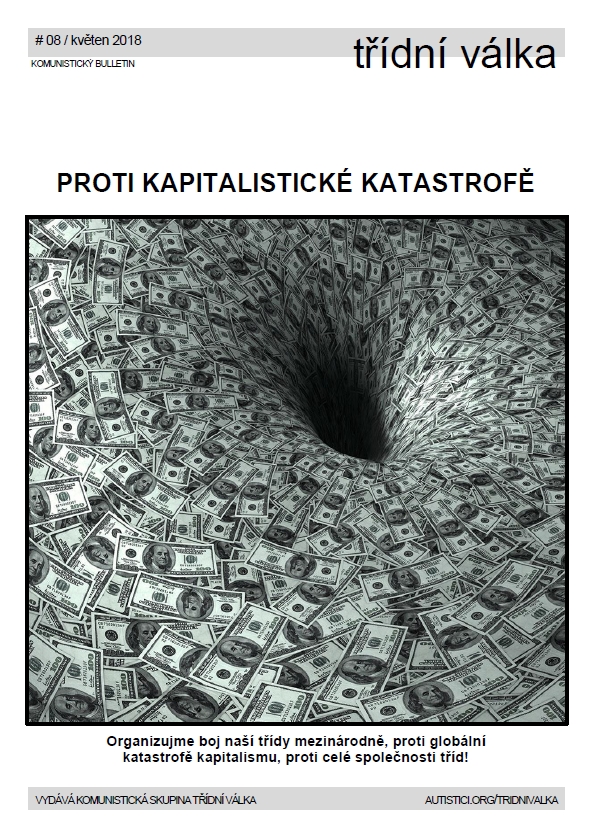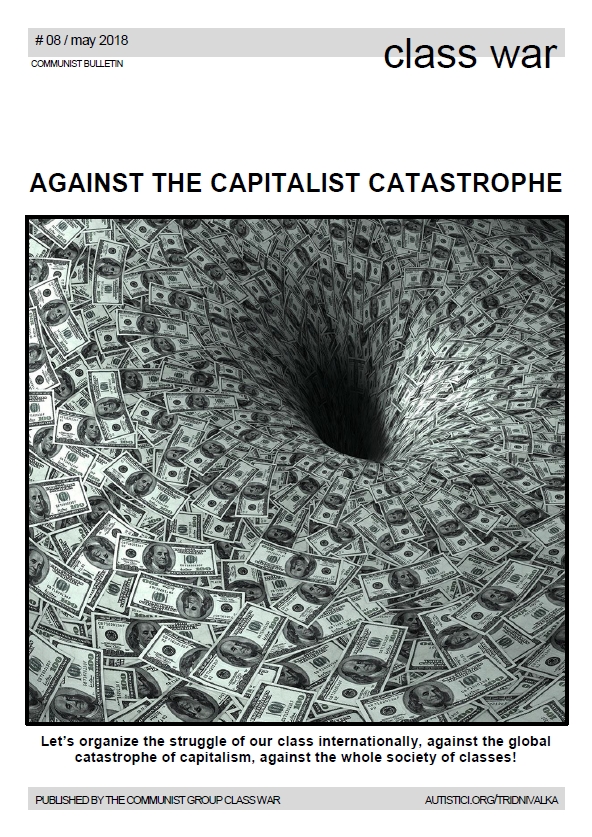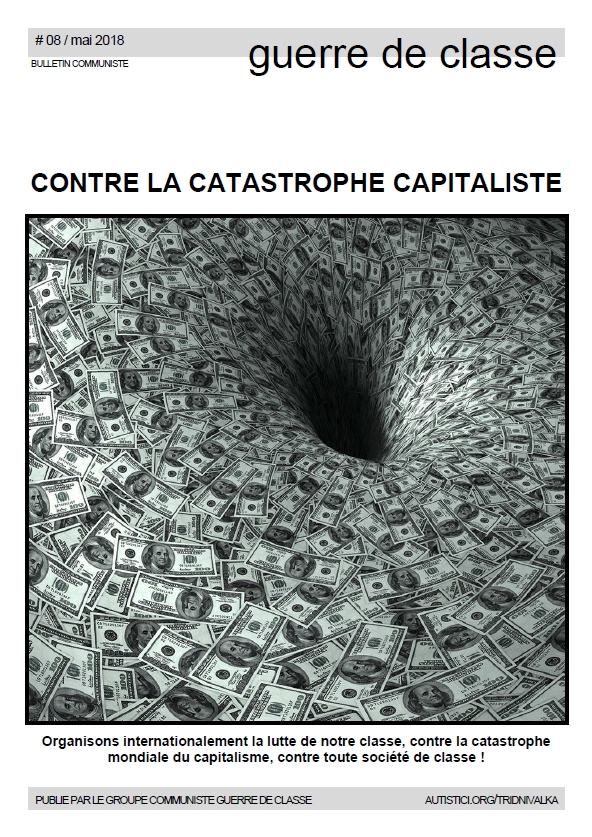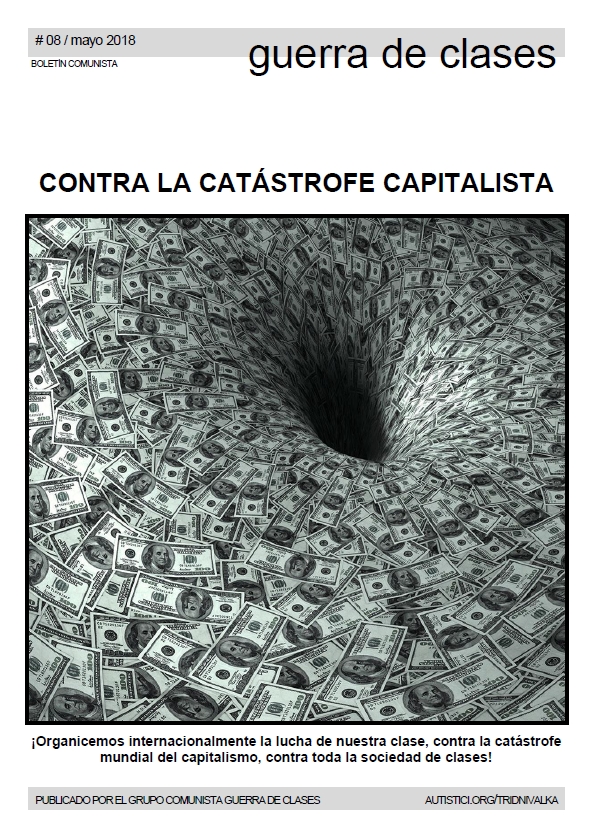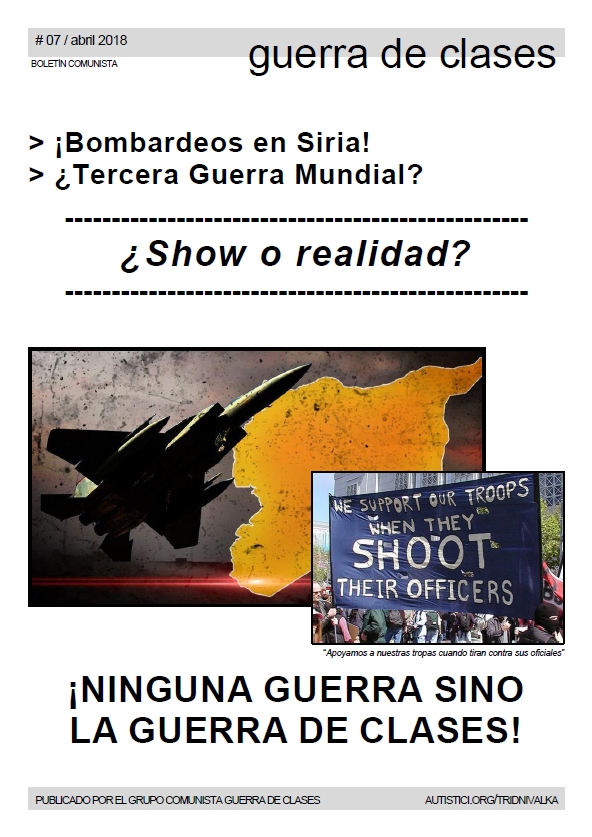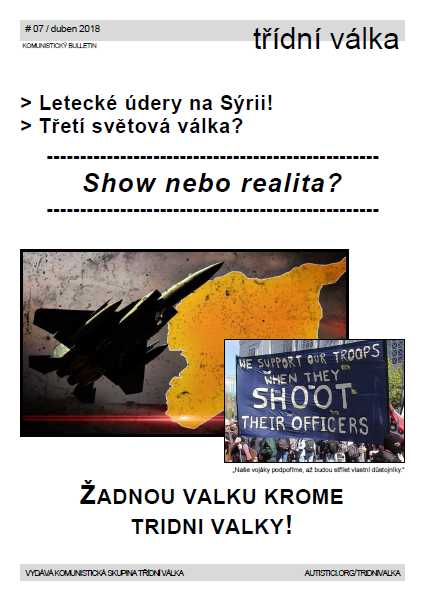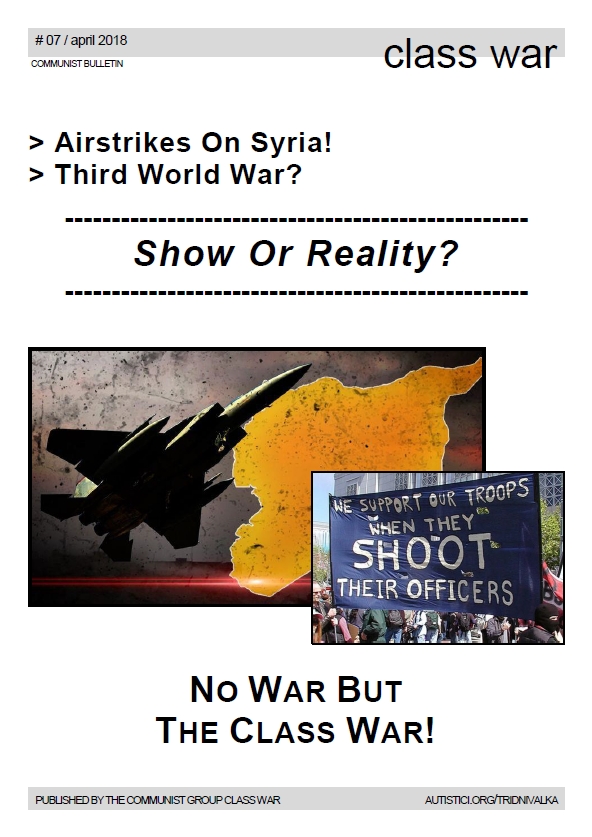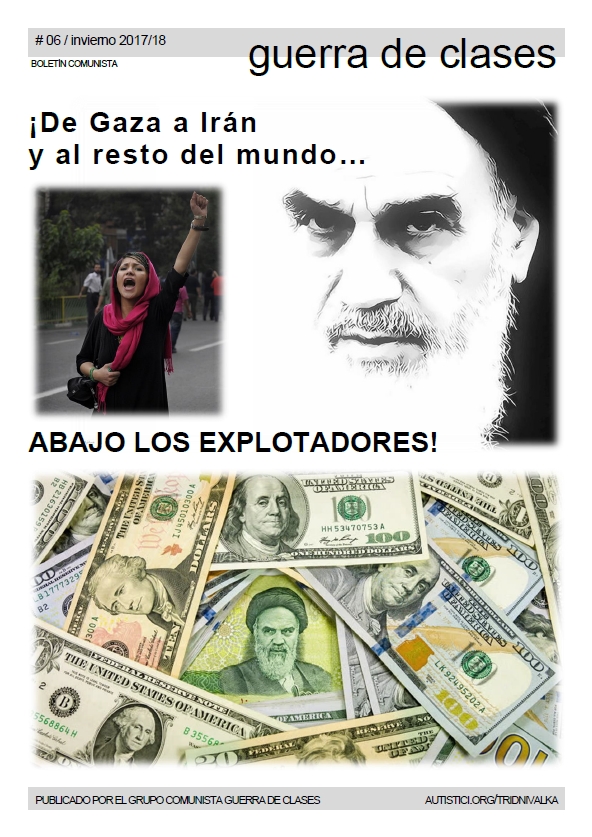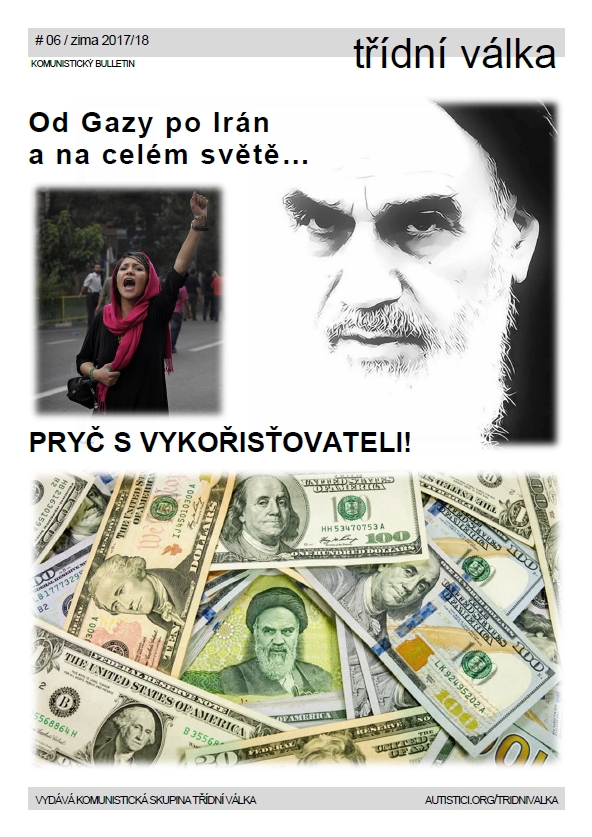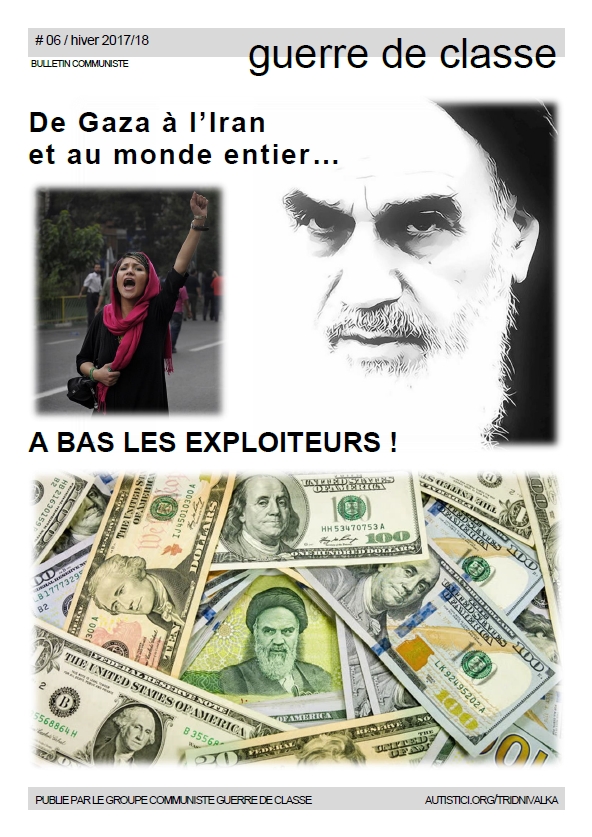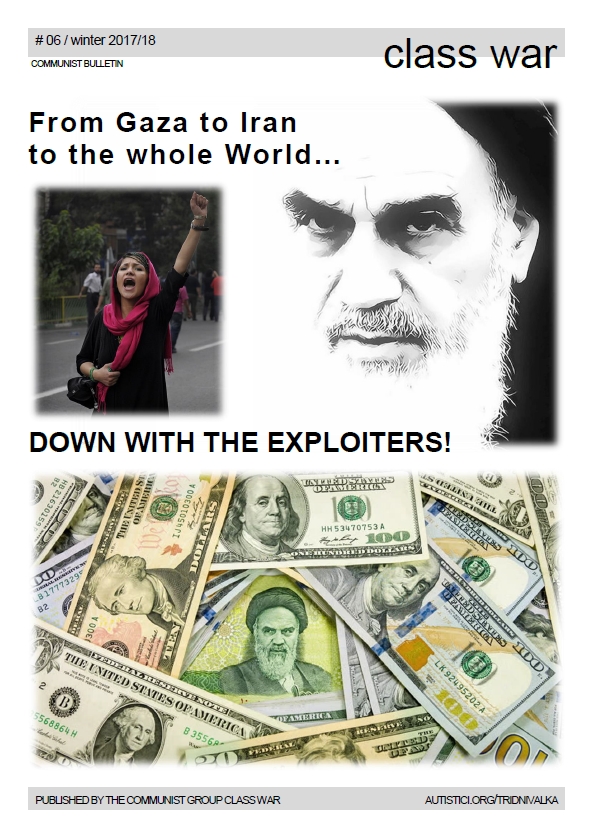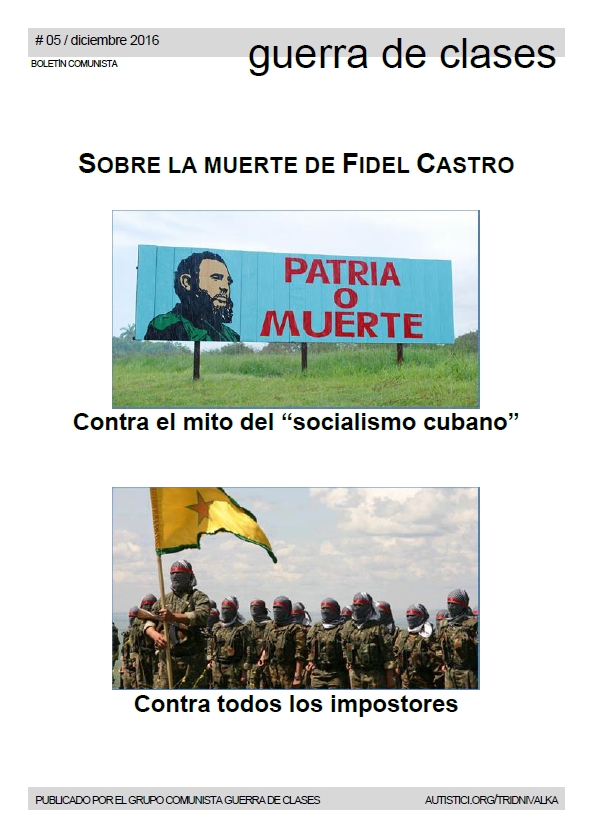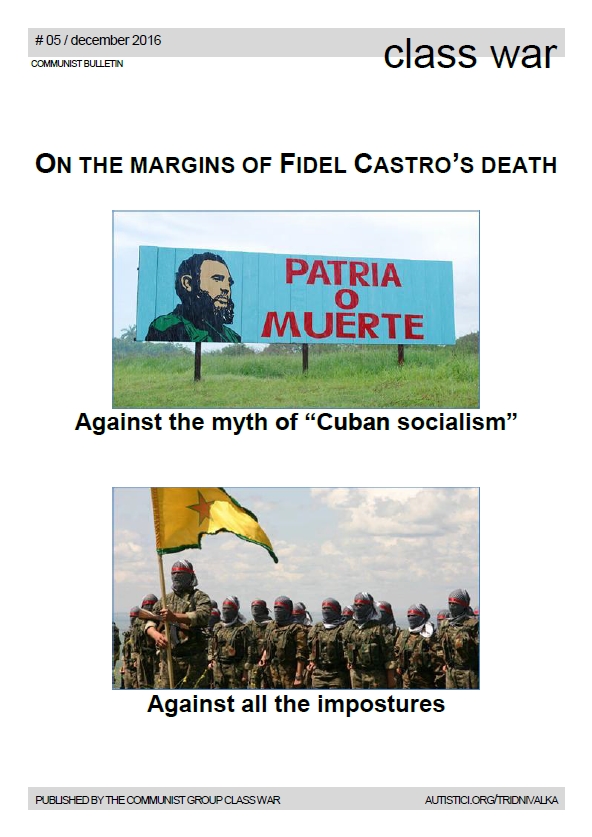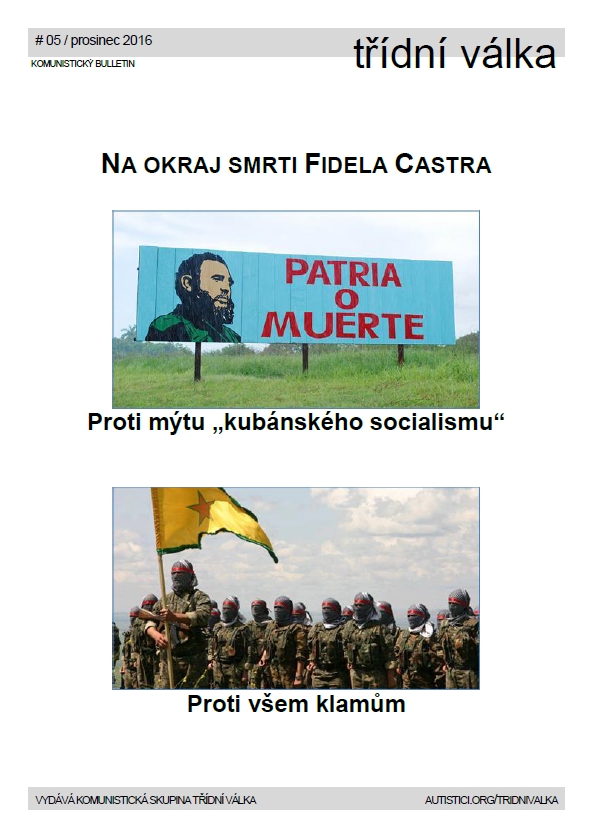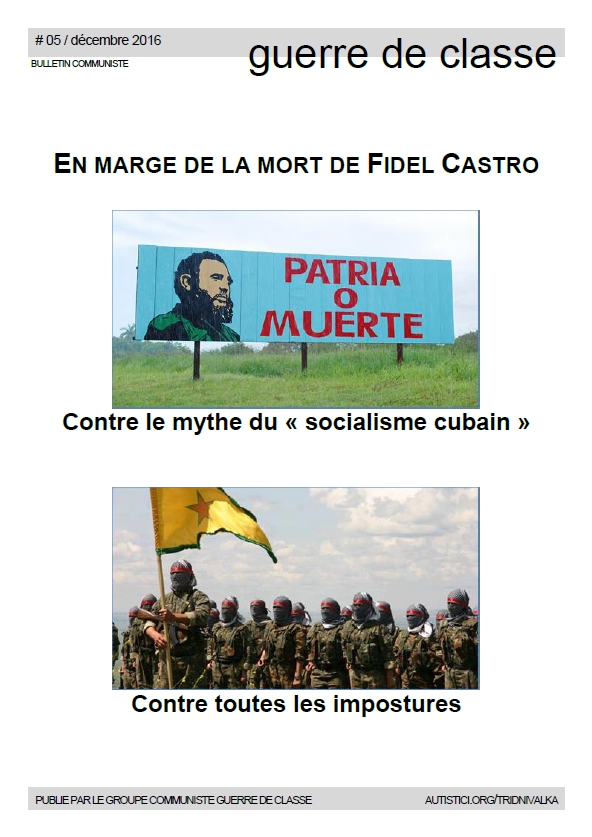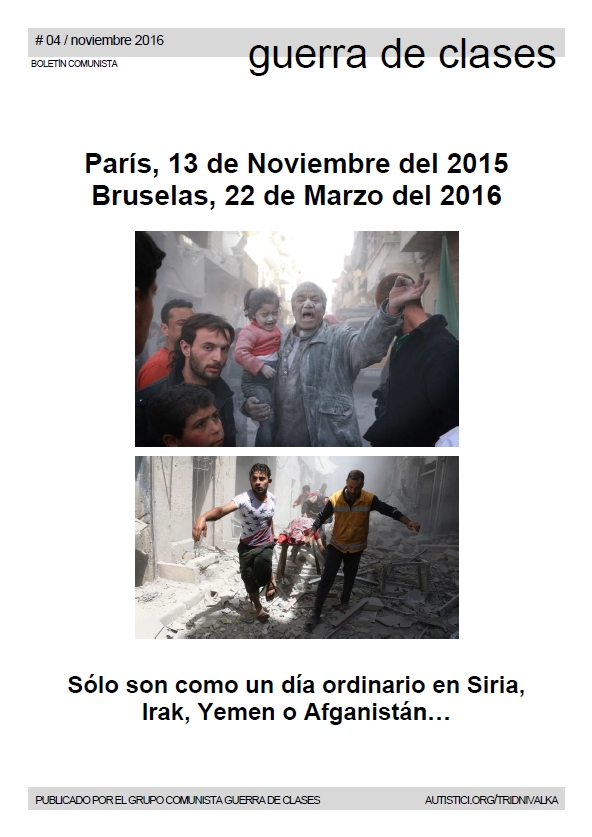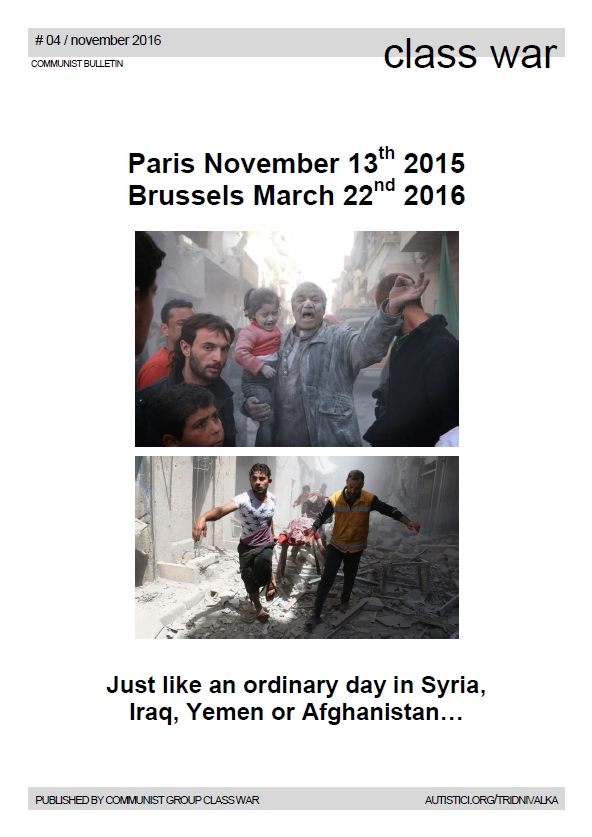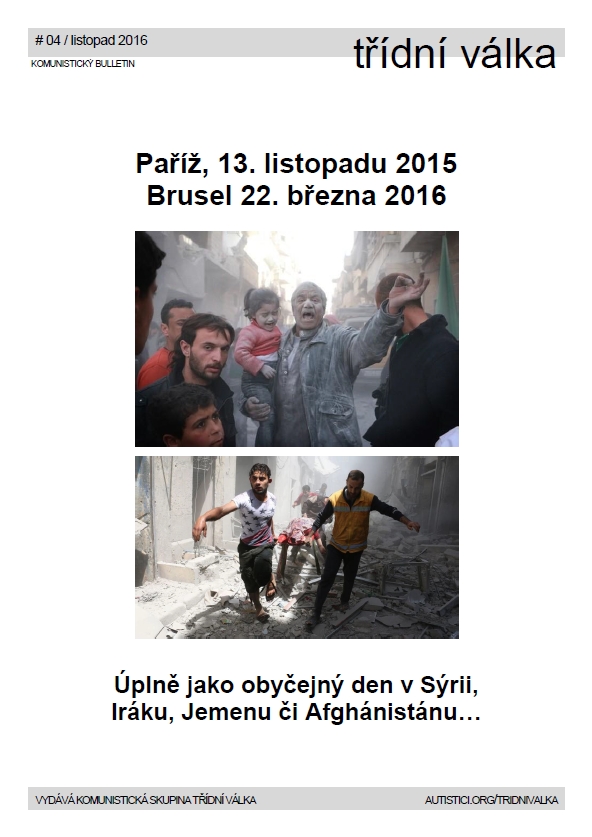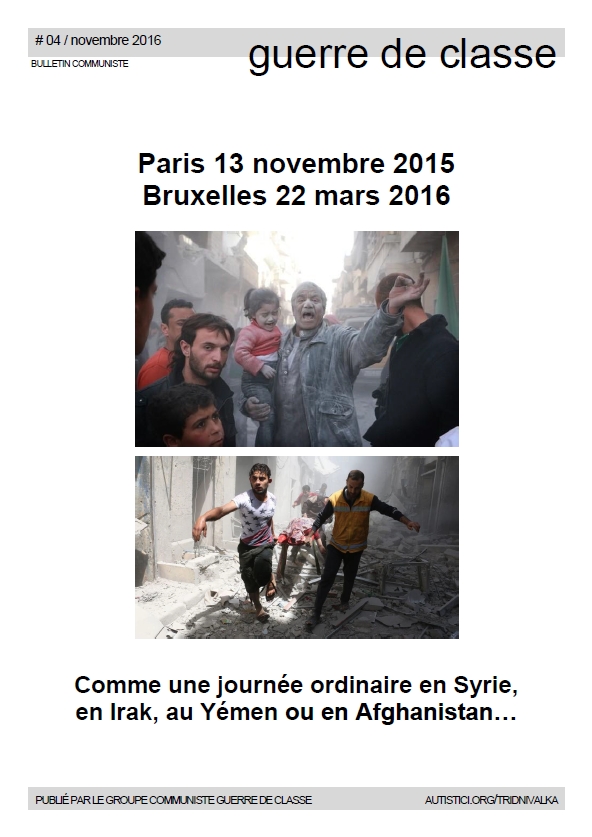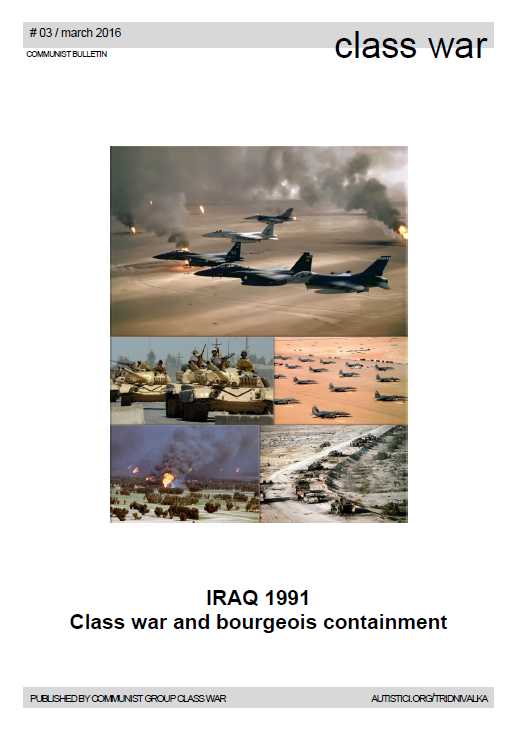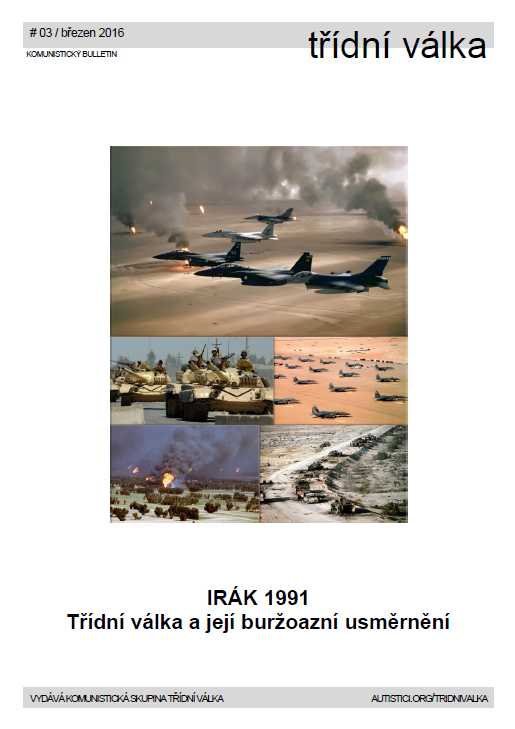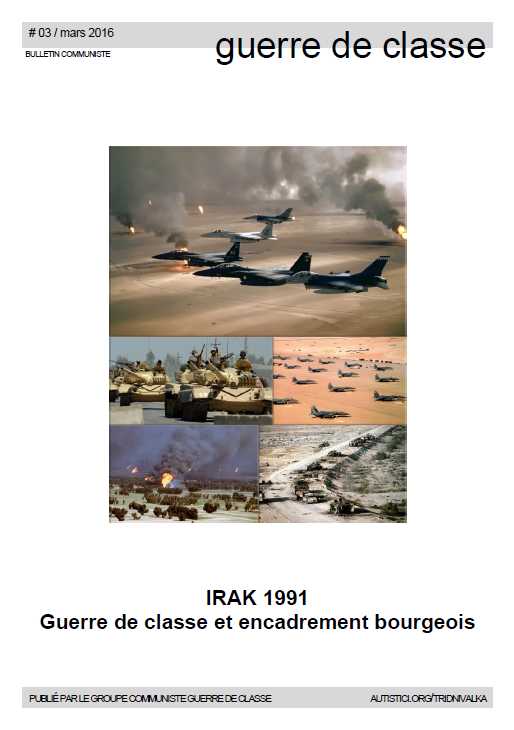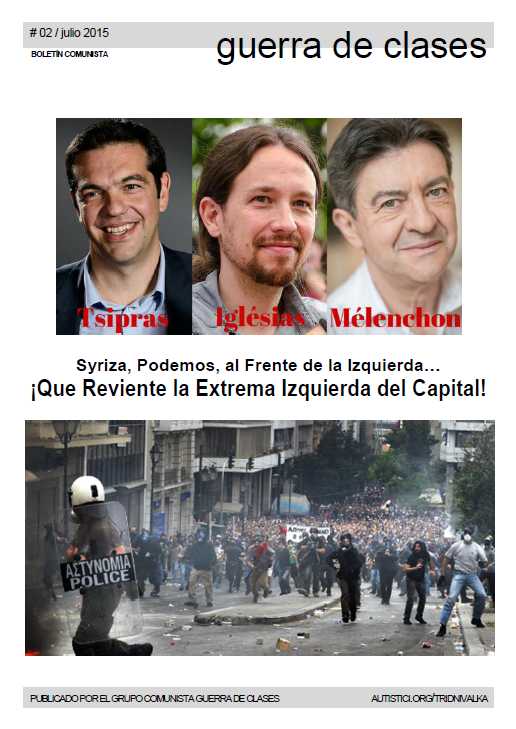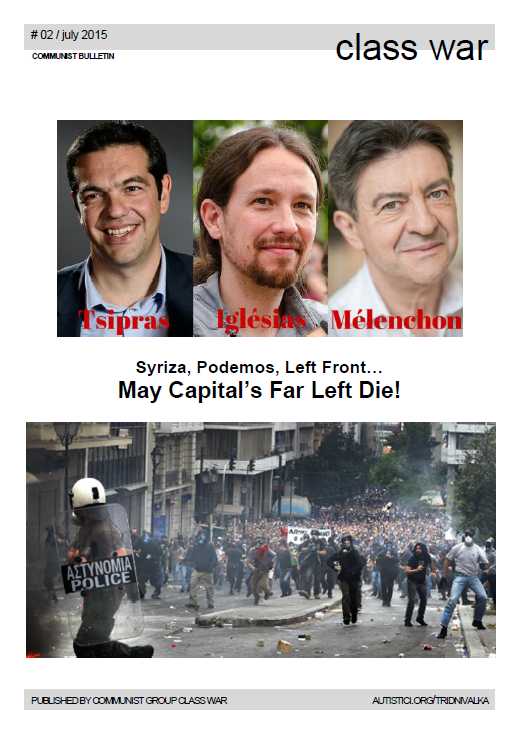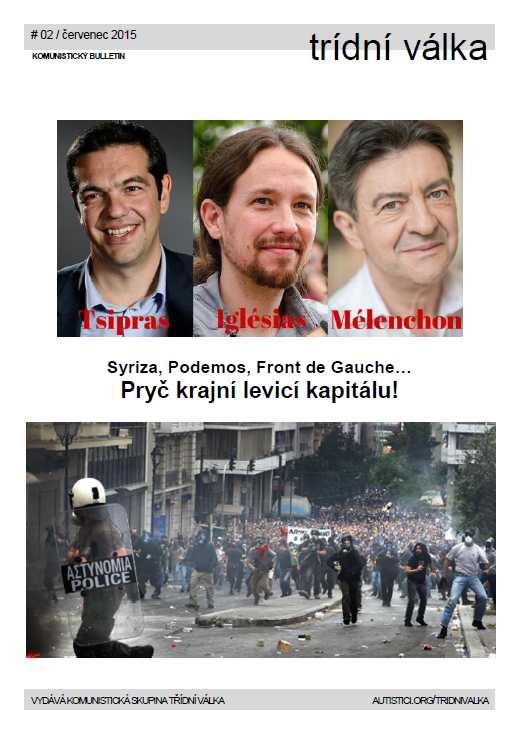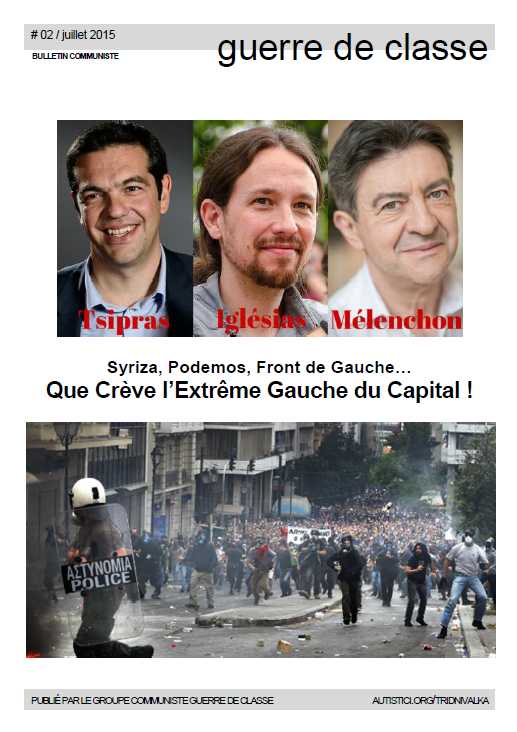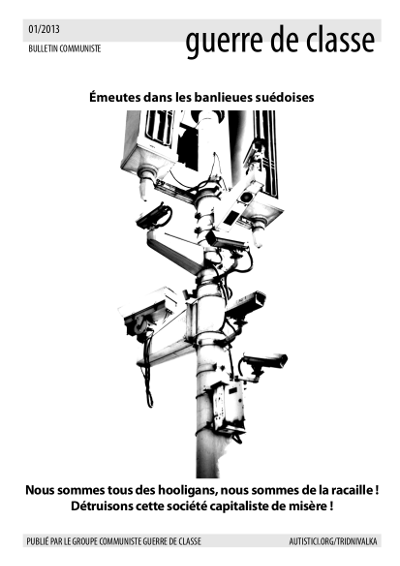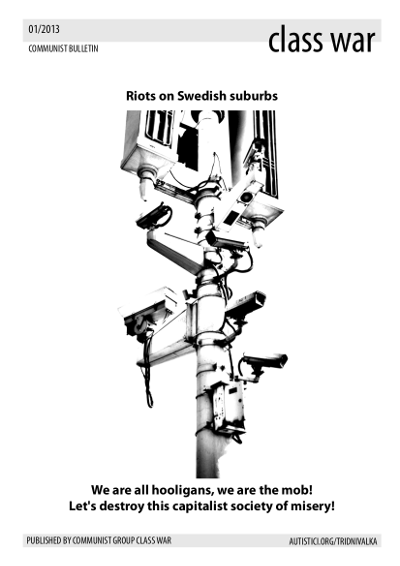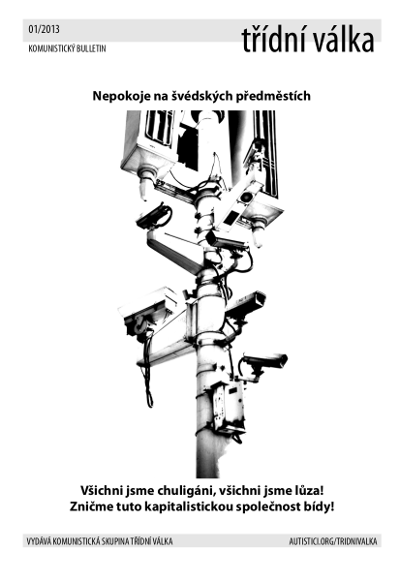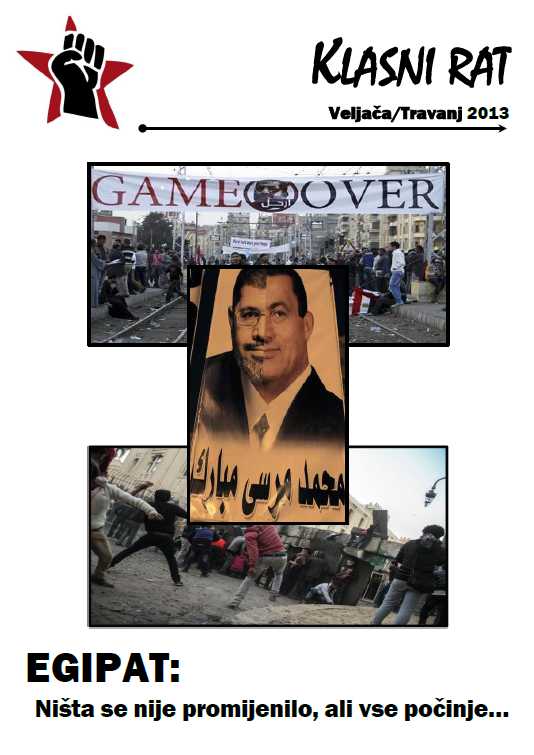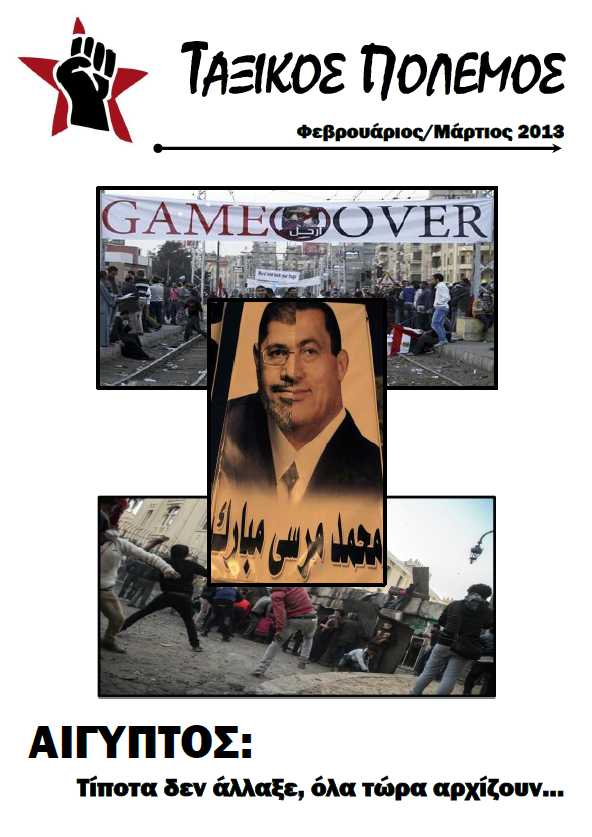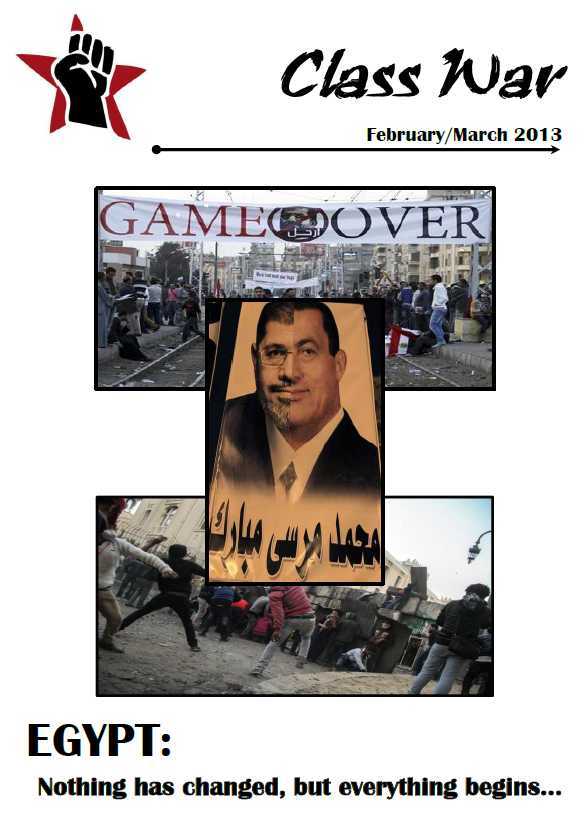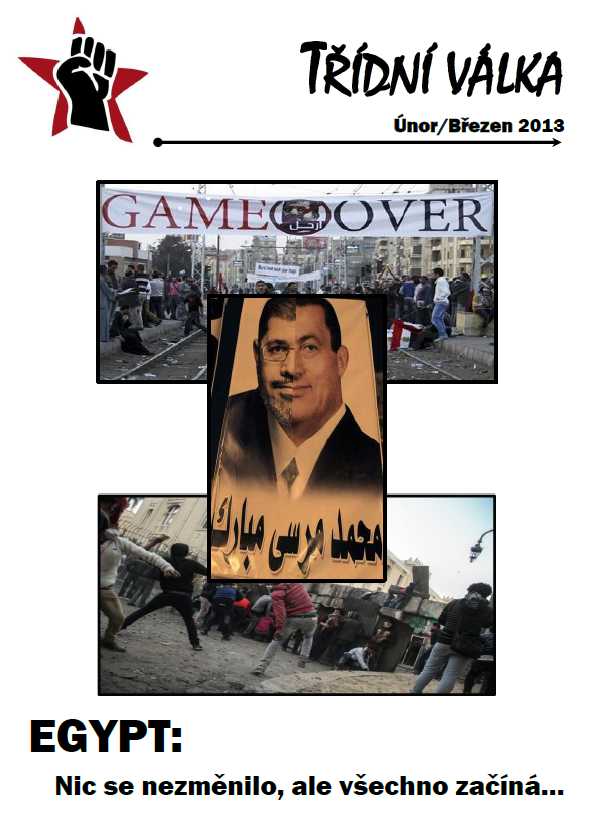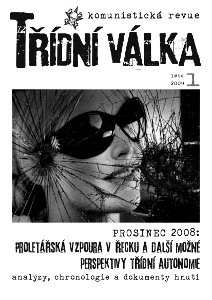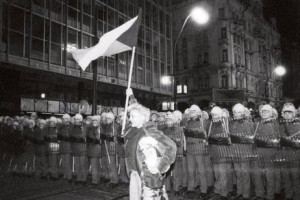 Events of November 1989 undoubtedly changed life of – today already divided – Czech and Slovakian society and to understand their content is an essential element for grasping presence. Unlike KPK, we do not think, that local “radical left” tries to avoid analysing these events[1]. But it does so in accordance with its nature: because it is an extreme left of the bourgeois political spectrum, it is not possible to expect from it a revolutionary critique of capital as a social relation. Czech and Slovak extreme left is diverse in its forms, but as for its content it is a continuator of Social Democracy as a historical tendency to reform capitalism. That is why with leftist “anarchists” and Trotskyites we encounter a critique of the former regime, which is unambiguously based on its undemocratic character and on a vision of a democratic planning (whether through the State or for instance communes). The question of “real existing socialism’s” class character, which has always been a key question in anarchist polemics against Trotskyites, who mostly do not consider it as a class society, was not a question of critiquing the mode of production as the content of corresponding forms of social relations, but once more it was primarily a critique of hierarchical relations between order-givers and order-takers, thus again a question of democracy. What wonder then, that for example both the Trotskyite Socialist Alternative Future (the Committee for Workers’ International) and “anarchist” Czechoslovakian Anarchist Federation see November 1989 as in fact an incomplete revolution? Indeed, the democratic content of this bourgeois political revolution is their own content! We just needed to democratise more and thoroughly and that is why on anniversaries they easily can periodically chant: “Repeat, repeat, repeat it!”
Events of November 1989 undoubtedly changed life of – today already divided – Czech and Slovakian society and to understand their content is an essential element for grasping presence. Unlike KPK, we do not think, that local “radical left” tries to avoid analysing these events[1]. But it does so in accordance with its nature: because it is an extreme left of the bourgeois political spectrum, it is not possible to expect from it a revolutionary critique of capital as a social relation. Czech and Slovak extreme left is diverse in its forms, but as for its content it is a continuator of Social Democracy as a historical tendency to reform capitalism. That is why with leftist “anarchists” and Trotskyites we encounter a critique of the former regime, which is unambiguously based on its undemocratic character and on a vision of a democratic planning (whether through the State or for instance communes). The question of “real existing socialism’s” class character, which has always been a key question in anarchist polemics against Trotskyites, who mostly do not consider it as a class society, was not a question of critiquing the mode of production as the content of corresponding forms of social relations, but once more it was primarily a critique of hierarchical relations between order-givers and order-takers, thus again a question of democracy. What wonder then, that for example both the Trotskyite Socialist Alternative Future (the Committee for Workers’ International) and “anarchist” Czechoslovakian Anarchist Federation see November 1989 as in fact an incomplete revolution? Indeed, the democratic content of this bourgeois political revolution is their own content! We just needed to democratise more and thoroughly and that is why on anniversaries they easily can periodically chant: “Repeat, repeat, repeat it!”
There are three reasons, why the KPK pamphlet is a valuable contribution to an effort to make a real class analysis of the “Velvet Revolution”. First, it does not try to put historical facts on a Procrustos’ bed made of an ideological framework and to cut off or neglect everything unsuitable. Second, while viewing these facts, it puts on an armour of a somewhat vague term “Marxist method”[2] (which can be everything, including Trotskyite ideologizations), but according to the way it operates, its method is easily identifiable as a certain form of a historical ultra-left’s heritage (in form of inter-war communist lefts, Italian operaism and autonomist Marxism), ultra-left which has delimitated itself as a critique and an attempt to overcome a pro-capitalist ineptitude of extreme left. Third, because its pamphlet is empirically quite a rich and good summary of at least political events in November 1989. However, strengths are linked to general limits of this pamphlet, which we will examine first, so that we can keep compliments for the conclusion and do not pointlessly deter readers from reading it, because it would be a mistake not to read it!
Weaknesses
If the particular form of “Marxist method” represented by the KPK and (as is evident also by) the Mouvement Communiste allows them to avoid the crudest ideologizations of social motion at the end of the Eastern Bloc’s existence, we think that at the same time it leads them into more subtle ideological traps of bourgeois thought. Unfortunately, they fall into two of them before they even start to write their work.
First, when in the “Introduction” they suppose existence of a “neutral historical viewpoint”[3], which they refuse to use for looking at November 1989. We believe that it was probably an awkward way of expressing themselves from the side of the KPK, nevertheless we have to address this idea. What appears as a historian’s neutral viewpoint and what proudly proclaims to be such a thing, comes to existence as a product of capitalist society class relations and it cannot escape behind their horizon, it cannot uplift itself over that horizon. Therefore, it is necessarily a subjective viewpoint: either a bourgeois or a revolutionary proletarian one.
The second, this time completely real, trap springs, when the KPK decide to deal only with a political level of that social motion; as they say, to limit themselves to “the very process of delivering power in November/December 1989” and thus to detach from a “global and wider historical context” and from an economical level.[4] We can understand very well an excusatory reference to “demandingness of the topic” (neither our strengths allowed us to make a very detailed and complex analysis), but we think that behind an evidently present, though unspoken, supposition, that the whole question of Stalinist collapse can be quite scot-free narrowed in this way, there are shortcomings of the used method. There is a real existence of separation between economical and political levels for the capitalist society and bourgeois thought, but if it is not political economy what we aim at, but its critique, we must see both levels in their social unity. Likewise we must overcome separation between “national” and “international” events on the basis of global dimension of Capital. But because the KPK’s method operates differently, they created relief, nevertheless quite a cropped picture, limited in its possibilities to understand the historical process at the end of 1980s.
The KPK reaps inauspicious fruits of the fact that they follow bourgeois separations (what appears as a residue of Social Democratic Marxism ala the Second, Third and Fourth Internationals) every time, when they try to define the content of the November movement, ante-November dissent or the Civic Forum (hereafter abbreviated as the CF). An analysis closed within the political level can’t go any further than saying it was a movement/opposition with a civic perspective; it is an a-class analysis.[5] Though the KPK carefully avoid saying it openly, between lines they work with an undeniable fact that the civic perspective is a capitalist perspective and as such it needs its bearers – therefore, social classes of the capitalist mode of production, whose social practice it would express. However, the only class existing in the text is the proletariat, who, as we will speedily see, is not supposed by the KPK to be the source of this citizenship. Besides the proletariat, there are government heads of the Czechoslovakian Communist Party (CCP), but also “members of the nomenclature getting through their engagement in company conglomerates into the positions of big businessmen”[6], the dissent and the CF. The former try to “privately invest their wealth in a form of money capital,”[7] the latter bind the proletariat with a velvet tricolour so that it doesn’t happen to come into its mind that it could rebel. But why do both act in this way? Is their ante-November as well as November activity independent from the contradictory relation capital-labour and thus is not an expression of class polarisation in the society?
Where and who was the bourgeoisie or the ruling class called in whatever way as a personification of capital, what was the class nature of the dissent and the CF – that is what the KPK doesn’t say and even ask, because a mere analysis of politics can’t become of itself a class analysis. In order to cover up this, for “Marxists”, striking hole, the KPK tell the reader that the Prague leadership of the CF was “an organ of entirely non-workers composition” (as well as the dissent).[8] Indeed, it is a very feeble patch, woven of the worst workerism (it is here that the KPK’s method demonstrates its operaist roots in such a way, that perhaps even the original Italian operaists feel a little bit uneasy in their graves). Was specifically the dissent really without proletarians or is it all about the good old “worker” as a sociological category? Is it an indication that if there were more factory workers in the CF leadership, everything would have looked differently, because when they start to move, they can’t reproduce a bourgeois perspective?
As toothless the KPK’s analysis becomes, when it comes to the collapse of the whole Eastern Bloc. We only learn that the USSR was refusing to interfere in internal affairs of its satellites and just by the way, on a completely different place, we are told that there were some strikes in the USSR. We can read that Eastern Germans were fleeing through Czechoslovakia to the West and that the representative of the Polish “junta”, Jaruzelski, recommended to the CCP to learn to co-exist with the political opposition. Thus, we get indications that something was happening throughout the Eastern Bloc, but not a slightest attempt to grasp and explain what it was. Why? We think that without a parallel analysis of the economic level and the place of “socialist” economies in the world market it is not possible to get much further. Even the KPK bounce against this limit of their own method, when the question of “why actually did ‘the Velvet Revolution’ come” is inevitably raised and possible “explanations” offered exclusively by an analysis of politics are more than unsatisfying and, obviously, they would just retell some of bourgeois “explanations” which are circulating over here. That is why, in such moments, the KPK try to tackle a question of the economical level.[9] It’s a pity that answers are rather insinuated by them, because it seems that they can have a lot to say. Definitely, it’s possible to say that as much as they see the former regime’s nature as capitalist, insist on a necessity to view that regime through categories of value and commodity (although it’s a paradox that their pamphlet is not based on them) and indicate existence of crisis at the end of 1980s, our views meet. Thus, there’s nothing else to do than to look forward to the second volume of this pamphlet which is said to be devoted to the economical level of Stalinism. In the meantime, readers have to be satisfied with a “Solomon’s” observation that it was “a change flowing with the current of history”.[10] That is evident, but it does not answer the question, “Why,” at all.
The last important weakness of (not only) KPK-style “Marxist method” is revealed while they try to grasp a role of the proletariat in the November movement, which once more brings us back to the content and therefore also possibilities of this social movement. In this sense, the KPK set as their goal: “In the first place we want to understand how the post-November ruling class managed to organise transformation of conditions and its coming to the sunny side so elegantly and self-assuredly. What was lacking on the side of the working class that the collapse of Stalinism resulted in a well-known outcome?” Already in advance they indicate which way their answers will go: “Indeed, it unleashed social dynamics, it opened a space, which was until that time monopolised by the State and the Party! Indeed, destruction of the old is always a fragile and potentially open-ended and uncertain situation!”[11] And eventually they say: “the class did not take advantage of a relatively open-ended match and was unable to intervene in it as a politically independent force.”[12] Why? As one the reasons they put a “successful strategy of the CF” which did its best to “dissolve a potentially subversive, political face of the proletariat in the concept of citizenship and democratic rights.”[13] There’s also an alternative reason – a not really specified “immobilisation caused by Stalinism”: “statism, whether supported by Stalinists, Trotskyites, or Social Democrats, is a weapon against proletarian autonomy.”[14]
At the beginning of writing our own texts, we had worked with similar starting questions and ideas how to answer all the possible whys related to November 1989. Nevertheless, we have been progressively finding them utterly insufficient, explaining nothing and ignoring important facts and finally theoretically mistaken.[15] We completely agree with the KPK that: “However, as a class with specific interests workers were not present in November events.”[16] In other words, the proletariat did not act as a class against capital. Perhaps, some briefly and on a very low level indicated something like that (we think that conscripts and a part of students), in order to come back through their conscious (in this case, as the KPK correctly says, civic) perspective to acting as a class for capital. But that’s where our agreement ends. We think that, if we are aware of this fact, all the concepts of relatively open-ended though unutilised matchs or “opportunities”, which the working class “missed”,[17] must be thrown directly into a dustbin as unuseful and confusing junk and we have to look for causes why that historical situation was “closed”. What makes possible for the KPK to easily keep to those concepts?
It’s their own method, which grasps the contradictory relation capital-labour more as a contradiction of two poles: on one hand there is capital and on the other labour as separated (thus in their essence autonomous) poles. Class antagonism is then understood precisely as a contradiction of two poles external to each other: in the case of the KPK notoriously described and explained as a clash of two alien armies on a battlefield or two fighters in a boxing ring. If both poles of the capitalist relation are apprehended as separated, everything what they are, how and towards what they act, in a mutual contradictory relation appears as something proper to their essences. Neccessarily, they appear as endowed with a kind of pre-existing nature (historical strategy): capital represented by the bourgeoisie tries to dominate in order to exploit labour and labour represented by the proletariat resists being exploited and dominated. Only on the basis of this revolutionary nature of the proletariat it’s possible to talk of its “political autonomy”. In what other way could the proletariat reach “political autonomy”, as a necessary condition and step towards (for the KPK) the communist revolution, if labour wasn’t a pole separated from capital and if the process of “autonomisation” wasn’t about a return of our class to its revolutionary nature? What would be “political autonomy” good for if the proletariat couldn’t find itself in it: its class consciousness, struggle organisations and revolutionary aspirations? If labour and capital were external to each other and what was at stake, is that the proletariat would rediscover its revolutionary nature through “political autonomy”, then reasons, why it’s not permanently in its natural, autonomous condition, and conditions, under which this return can happen, are completely external to it, because they depend on its opponent: the capitalist class. Thus, “open-ended situations” for building “political autonomy” can hypothetically exist permanently and the only things closing them down are exclusively external influences of the other pole, capital: for example ideological domination of the bourgeoisie, state repression or particularly in the case of the KPK economical crisis as a period rendering any more important proletarian struggle impossible.
And it’s exactly external influences, what the KPK serves us as an answer to the question, why the proletariat did not rise up in November 1989 for its own historical interests: diabolic machiavelism of Havel’s CF leadership and mysteriously demobilising dozens of Stalinist years (and hence of statism generally). If in the “conclusion” the KPK say that “the Velvet Revolution” resulted in creation of a “modern civil democracy with a diverse network of the civil society, which is able to integrate the proletariat more effectively (but never absolutely!) than the rigid Stalinist regime,”[18] despite that exclamation, “never absolutely”, a question is necessarily raised, what political form would the domination of capital have to take on, according to the KPK, in order to be favourable for development of “political autonomy”. Therefore, it’s obvious that we can’t consider the question, why the proletariat behaved in November 1989 primarily as variable capital, in this way and on the part of the KPK it’s only an outcome of their purely political analysis of the given social motion: there’s nothing easier than to slip to (explaining nothing) “explanations” (common in bourgeois discourse) from the viewpoint of political forms…
The KPK goes on to correctly say to the question of our class that proletarian struggle “is not linear, it doesn’t automatically start from a point it had already reached, in order to overcome it and gradually push the aim further and further.”[19] However, exactly this gradualism ironically appears in other KPK texts as the only way how to reach desired “political autonomy” – to build it step by step (even with interruptions and returns): the class will progressively get rid of bourgeois ideology and mediating institutions, it will come back its proper self and the question of revolution will be put on table. Trapped in this theoretical contradiction, the KPK seek a way out, in order to finally hover on one spot: “Moreover, the working class is not able to use its struggles in the way that experience and lessons drawn from the class struggle would continuously enrich its ‘war arsenal’. Too often, it repeats the same mistakes, buys similar tricks of capital and solves identical questions – or, better said, it forgets about partial answers, it has sketched during past struggles.”[20] Now we get a picture of the proletariat as a peculiar but totally sclerotic being. And the KPK want to refresh its memory through a “convincing theory which would be able to provide critique and lessons from struggles to future struggles,” and in this way, with their modest forces, contribute to building “political autonomy”. If the revolutionary potential of the proletariat was really based on this, our prospects – while overlooking results of “political autonomy” in history as well as today in other corners of the world – would had been more than tragic. As the Théorie Communiste note, currently autonomy celebrates a bitter victory: “self-organisation everywhere, revolution nowhere.”[21]
“Political autonomy” is a conception built on fetishisation of self-organised forms of struggle. It’s just another formalist answer to the question of the communist revolution, which is in reality a question of content of struggle, through which the proletariat transforms into a revolutionary class abolishing capital and therefore itself as a class. This formalism is expressed for instance, when the KPK criticise an undemocratic structure of the CF. Devil knows why, but perhaps precisely because the content of the November movement and class character of the CF as a whole remain mysterious for them, they make an eloquent parallel with proletarian struggles. These are, according to them, led by a resolute minority, trying to reach “the strongest possible unity of workers in struggle”, which is “a precondition to victory”.[22] It seems that the vanguard minority accomplishes this unity democratically and, therefore, it does not arise organically from the struggle itself, otherwise the whole parallel with the CF would be empty of any logic. This is also testified by griping about “a lack of self-activity” on the part of activists from lower ranks of the CF. A correct parallel works in both ways and that’s why the KPK tell us in one breath, that if only there was a proletarian self-activity, therefore, an action through which proletarians came back to their revolutionary natural condition, everything would had a different outcome. But, where is the content of the struggle? What’s left, is only form, the self…
At the end of the day, it’s sociologism of the workerist viewing of the proletariat, what’s coming back on the stage: if it’s not workers at workplaces, they talk only about students, actors, conscripts, as if a bulk of them wasn’t a part of the proletariat, wasn’t indissociably connected with it. But thanks to that the KPK can ignore a problematic moment of their November self-organisation – a problematic one, because with its content completely stuck in the civic perspective. If their self-organisation was insipid, the reason was that they acted predominantly as a class for capital, including workers of Prague ČKD factory, whose march to the centre of the city probably also did not lack a certain moment of spontaneity and salvific “self-activity” and self-organisation too. And it’s possibly here, where we can find the answer to a question, why the radical student wing did not push compromising dissidents aside and didn’t become a “leader” of the November movement: why the students would do that, when the content of their activity and self-organisation didn’t differ from dissent’s activity? The CF leadership was criticised on the level of democracy.
The KPK come back to formal explanations also at the beginning of a subhead called “A Dead Echo of 1968”. Let us quote: “If the working class was weak in November, it can be clarified by the fact that while the civic dissent could lean at least on some structures of its own, the proletariat was in a worse situation. If the class was not prepared, it related to the fact that it could not lean on any experience of struggle brought to it by 1970s and 1980s. The Czechoslovakian proletariat didn’t experience its own Gdansk.”[23] A well-known representant of the Dutch-German Communist Left, Anton Pannekoek, wrote sometime somewhere that, “the working class is not weak, because it is disunited, but it is disunited, because it is weak.” Similarly, also in Czechoslovakia a non-existence of workers’ structures was rather a consequence of weakness of our class and not its cause. We think that this weakness we have to understand as a fact that for more than two decades it almost didn’t constitute itself as a class against capital and to look for a cause in its defeat during the first half of 1950s as well as in a subsequent compromising modification of its relation to capital, which didn’t provide it for a long time with neither acute reasons nor space to rebel. From this viewpoint, the situation in Czechoslovakia wasn’t identical with a Polish one, where exploitation was not managed in such a compromise way, and that’s why there was no Gdansk. After all, in Poland 1980s there was self-organisation on the agenda, but there was no “political autonomy” and revolutionary perspective arising from it…
This is one of the elements of our analysis we have reached in long debates about historical facts as well as about a method how to grasp them. Now, to make things clear, we will try to briefly summarise it. As exploitation is at the same time contradiction and mutual relation between labour and capital, it implies that neither of these poles of the relation is autonomous, it doesn’t exist from itself and for itself: one doesn’t exist without the other, they produce and presuppose each other. In the mutual and at the same time contradictory relation both classes of the capitalist mode of production define themselves too as personifications of those poles: the proletariat and the bourgeoisie. The class struggle over a rate of exploitation is unavoidable for this relation. Therefore, within this relation the proletariat more or less transformis itself through struggle from a class against capital into a class against capital and the other way round, until it, as a class acting against capital, bounces against the limits of capital as a social relation and attacks them, ie. begins to dictatorially abolish itself and capital through abolition of the wage relation, exchange and money. The revolutionary capacity of the proletariat, therefore, exists and attempts at its realisation arise only out of the mutual contradictory relation with capital. As Marx says, “the radical revolution can only be a revolution of radical needs,”[24] and does not wait for a successful completion of building “political autonomy” with workerists’ good advices, as this “political autonomy” is a pre-supposition of the revolution only in romantic dreams based on the Italian movement of 1960s and 1970s.
Besides what we have said above about the defeat of our class in 1950s and the imposed “class compromise”, what so far flows for us from this viewpoint, is that Czechoslovakian capital in 1980s once more slides into a crisis. Unlike 1960s, it’s not only its own crisis, but a crisis of the whole Soviet bloc, which rapidly looses its competitiveness on the world market and implicitly its capacity to efficiently exploit proletarians. That’s why any kind of “fraternal help” from the Warsaw Treaty armies is this time out of discussion. Long-time stagnation and consequent beginnings of the crisis in the Czechoslovakian Socialist Republic lead to difficulties in reproduction of labour power, relating to spheres of consumption and services, and growth of a parallel economy which creates a possibility for primitive accumulation of financial means and thus a diverse stratum of people pregnant with private-business ambitions. The dissent and later the CF are political expressions of both these ambitions and reformist expectations of the working class. And a pro-reform part of the then functionaries of capital, the then ruling class – that bureaucratic-technocratic bourgeoisie – also gambled on those expressions. That’s all we are able to say for the moment. Let us once more quote, just for pleasure, the old beardie, because his observations on German conditions in the mid-19th century strikingly resemble the state of the Czechoslovakian society in 1989:
„On the other hand, the present German regime, an anachronism, a flagrant contradiction of generally recognized axioms, the nothingness of the ancien régime exhibited to the world, only imagines that it believes in itself and demands that the world should imagine the same thing. If it believed in its own essence, would it try to hide that essence under the semblance of an alien essence and seek refuge in hypocrisy and sophism? The modern ancien régime is rather only the comedian of a world order whose true heroes are dead. History is thorough and goes through many phases when carrying an old form to the grave. The last phases of a world-historical form is its comedy. The gods of Greece, already tragically wounded to death in Aeschylus’s tragedy Prometheus Bound, had to re-die a comic death in Lucian’s Dialogues. Why this course of history? So that humanity should part with its past cheerfully. This cheerful historical destiny is what we vindicate for the political authorities of Germany.“[25]
Strengths
If we are aware of all weaknesses and pitfalls of the KPK’s method, we can proceed to assessing merits of their pamphlet with easy mind. To those, who would like to point out, while sneering, that this section is much shorter than the critical one, we send a message that we don’t belong to ones, who measure the importance of texts by number of lines or kilograms. Even if there was only one positive point to be made about KPK’s work, even if it was, let’s say, only one sentence of their analysis, still it would be of enormous importance that it was expressed, that this group brought it to the table and gave it for disposal to the whole militant proletarian community as an impetus for further thinking and action.
Undoubtedly the most important passages of the brochure can be found in the fourth chapter, “Anatomy of a Power Handover”, but a significant observation appears right at the beginning of the chapter called “Chronology”. The KPK succeed in identifying and designating dynamics hidden in the student demonstration of November 17 and in its repression, dynamics which led to the students’ and actors’ occupation strike and set off the whole movement: “the police action didn’t shock the participants just by the level of violence (568 injured, out of whom 180 with possibly lasting consequences), but precisely and primarily by a contrast between a sense of power and victory during the demonstration – and the repressive gesture of the state at its end” (CWG’s emphasis).[26]
The November movement thus began and the KPK, in quite a detailed and excellent way, set about describing its trajectory, its components and their mutual relations and negotiations with the Stalinist ruling class in the above mentioned chapter. What could be more pertinent, than to call the spontaneous and self-organised plodder of the movement – students – as a “brutal force” held on a leash by the dissident leadership of the CF?[27] In their relation to striking students, actors and demonstrators in the streets, dissidents regrouped into a leading body of the CF proved to be apt representatives of the democratic content of the movement and skillful manipulators, practical leaders and ideologues, because they were well aware of the bourgeois character of their social change programme. Many of their declarations provided by the KPK testify to this as well as confirmation of political and economic liberalisation’s biuniqueness through an effective co-operation with pro-market boys of the Prognostic Institute. The peaceful and backstage way of handing over the power is of the same importance. While reading these lines of the KPK pamphlet, we couldn’t help recalling operetta character of the bourgeois political revolution in October 1918, which we discussed in our pamphlet Down with Tyrants and Traitors All! Certain traditions of the Czech and Slovakian bourgeoisie are obviously very durable and in hindsight we are always well entertained by liberal yellow-bellies and moderate managers of political compromises, who later boast what a kind of intrepid revolutionaries they were.
Their greatest merit both in 1918 and 1989 was that they contained crowds in the streets and till this day they are duly proud of this “velvet”. We have to somewhat deflate all those haughty Havels, Malys, Pitharts and Klauses by pointing out something we have already monished the KPK to: everything went so easily just due to the crisis of the Stalinist form of the capitalist relation in its Czechoslovakian variant, which opened exactly this situation with a possibility of a peaceful transition from one form of capital’s political domination to another and connected transformation of the bourgeoisie on the basis of property relations and capital restructuring. Simply put, they were lucky to be born and to live in the CSSR and not for example in Poland, the USSR, Yugoslavia, Rumania or Albania – there, they would have been unable to avoid this or that kind of a violent conflict even with a mouthful of Truth and Love triumphing over Lie and Hatered. The outcome of the whole process would have been the same as in Czechoslovakia, but perhaps some of our “dear” heroes of democracy, civil rights and liberties (and thus necessarily also property restitution and privatisation and primarily intensification of labour exploitation) would not have lived until its end (which surely doesn’t mean that their death would be a kind of big loss).
Nevertheless, as the KPK correctly say: “The fact that the November change didn’t go against the current of history, however doesn’t mean that we should downplay the role of its very actors. Despite their uninterrupted progress, the events didn’t free the opposition from an obligation to very carefully think over and manage the change.”[28] And they don’t free Communists from an obligation to analyse this level. If we elaborate more the KPK’s vague formulation, “a change flowing with the current of history”, as a change flowing from structural difficulties of Capital as a social relation, it doesn’t mean that as soon as the reason of this change and the cause and limit of an active proletariat’s participation in the change is resolved, there’s nothing anymore we should try to understand. The contradictory capitalist relation is not a relation of two symmetrical poles – if it would be, there would be no contradiction. Capital is a dominant pole of this relation which also contains resistance of the dominated pole that has to be put back on its place in this conflictual relation. It’s this, where a necessity of bourgeois coercion, repression, manipulation, ideological lies etc. stems from. The KPK collect a whole pile of evidence of virtuosity with which the CF leadership moved within this sphere of manipulation.
What is a really thought-provoking point in the KPK’s analysis, a point important for grasping the social reality leading to November 1989, is the conception of “Stalinist hyper-politisation and dissident a-political politics” as “two sides of the same coin”.[29] The KPK are surely right that under the conditions of the “real existing socialist” society (a specific form of the capitalist society) everything was over-politicised, because the political life wasn’t separated from the civil society and then Havel’s “a-political” politics appeared as a logical civil alternative and more over quite a radical one.[30] Such were boards of the then civil thought, which were arising from everyday social relations and practice and “The Power of the Powerless”[31] was in the first place their reflection and not “a means to do the proletariat out of its trump ace hidden in a sleeve – political autonomy”[32] as the KPK believe. But an effort to disguise a class character of the capitalist society is in no way a particularity of the “a-political politics”, as could be an impression from the KPK pamphlet. It’s a characteristic feature of bourgeoise politics in general, including the Stalinist one. If “the CF’s ideology, that dominated to the post-November life, was first of all an implicit rejection of Marx’s ‘political power is an official expression of class antagonism in the bourgeois society’,”[33] then every form of government and first of all democracy is this implicit rejection (or better a disguise).
Perhaps, it’s worth dealing with how and why the separation between the political state and civil society was wiped off. If we find an origin of the Soviet model in the Social Democratic counter-revolution born out of the womb of the Russian revolution 1917, then we can see that Bolsheviks as the most important agents of that counter-revolution carried out just a re-organisation of capitalist social relations and thus of the State and economy, while in their ideas moving between conceptions of orthodox objectivist Marxism and Jacobinism. We don’t want to explain a real social motion through ideas. Rather we would like to point out that those political conceptions found a fertile ground and material source and strength of their own transformation into a tangibly realised form, inside the reality of the pre-revolution Russian society, where the political state wasn’t fully born out of the civil society yet, and inside the social reality in the course of the proletarian revolution, which attacked both these spheres of the bourgeois society, only to get stuck in at the limit of workers’ management of means of production and Soviet democracy (ranging from their Bolshevik to for instance Anarcho-Syndicalist or Maximalist variants). The Bolshevik dictatorship thus necessarily acts as a political dictatorship harbingering the advent of pure democracy. We can’t help noticing a similarity not only in appearance, but also in content with Marx’s view of the French “bourgeois” revolution:
“…in periods when the political state as such is born violently out of civil society, when political liberation is the form in which men strive to achieve their liberation, the state can and must go as far as the abolition of religion, the destruction of religion. But it can do so only in the same way that it proceeds to the abolition of private property, to the maximum, to confiscation, to progressive taxation, just as it goes as far as the abolition of life, the guillotine. At times of special self-confidence, political life seeks to suppress its prerequisite, civil society and the elements composing this society, and to constitute itself as the real species-life of man, devoid of contradictions. But, it can achieve this only by coming into violent contradiction with its own conditions of life, only by declaring the revolution to be permanent, and, therefore, the political drama necessarily ends with the re-establishment of religion, private property, and all elements of civil society, just as war ends with peace.”[34]
This “permanent” suppression of still existing and through capitalist relations still revived civil society took a form of Stalin’s directive on “sharpening of the class struggle” while building socialism. When this directive came to the CSSR after February 1948 it was a mere shadow of its former strength and it rapidly died with the end of “the personality cult” to be replaced by a Party regimentation of the civil society and the “Prague spring” in 1968 was already an indication of how and through what this “political drama” would culminate in November 1989. However, it’s necessary to remark that in reality this clash of the political sphere with the civil society didn’t happen on its own, but along with the “economic” accumulation of Capital and in a mutual relation with it.
The last important contribution of the KPK to the given topic is according to us the information they found on dissatisfaction and struggles of workers at workplaces during 1989 and on resistance at the beginning of 1990.[35] Both testify to the fact that the class antagonism practically manifested itself also through proletarian struggle, but its intensity was very low and its content didn’t go behind the framework of Capital. Under the then crisis situation, a diffusion of even those struggles with minimalist demands could have been potentially explosive, but there was nothing like that – “the Velvet Revolution” finished this development with a climax that was arrived at even in those Eastern-European countries, where after all our class acted more strongly against Capital, however, without questioning the general framework of the capitalist social relation at the end of the day. To expect that Czechoslovakia could have been an exception, if… belongs to the realm of political dreams.
What to add at the end?
We are not going to prolong all this by embarrassing phrases. The KPK pamphlet “November 1989: The Proletariat Bonded With A Velvet Tricolour” definitely should not go away unmentioned. No doubt, the KPK did a lot of work while searching information, which makes their pamphlet interesting and readable. But we are not sure, whether they didn’t get sometimes a little bit lost in the sea of new data and details, like if they were always able to use their sources only as sources and not to tend towards reproducing their point of view. Just to completely relief all this at the very end, it’s worth noting that this “falling prey” to the sources gets a comical form in describing everything that is outside Prague, including the whole Slovakia, as “the countryside”. Probably it’s a concept, which infiltrated the KPK text from a book of a witless dissident, who needs a compass even to get on the outskirts of Prague…
We believe that the KPK brochure is worth reading and we heartily recommend it to everybody. We consider as good to read it very carefully, but also critically – however that depends on the reader. In any case, despite all our criticisms we consider it as an important and contributing step on the way to a true and compact class analysis of the fall of the Eastern Bloc and its transformation. But definitely, it’s neither the last nor an unproblematic step…
You can download the pamphlet in Czech here: http://www.protikapitalu.org/down/listopad1989.pdf
Class War Group
February 2010
[1] Collectively Against Capital: November 1989: The Proletariat Bonded With A Velvet Tricolour, (2009), “Introduction”, p. 5.
[2] ibid., “Instead Of Conclusion”, p. 38.
[3] ibid., “Introduction”, p. 5.
[4] ibid., “Introduction”, p. 6.
[5] ibid., “Anatomy of a Power Handover”, p. 25.
[6] ibid,. p. 23.
[7] ibid., p. 23.
[8] ibid., p. 20.
[9] ibid., pp. 13 and 23.
[10] ibid., “A Change Flowing with the Current of History”, p. 12.
[11] ibid., “Introduction”, pp. 5-6.
[12] ibid., “Instead of Conclusion”, p. 37.
[13] ibid., p. 37.
[14] ibid., p. 38.
[15] To give a complete picture, it’s necessary to add that in all this there has been also an influence of an ongoing debate around the Greek uprising in December 2008 and a related question (related not only with Greece 2008) of the contradictory mutual relation between the proletariat and capital, which was posed by Greek comrades of Blaumachen and texts by a U. S. communist Chris Wright and French Théorie Communiste.
[16] Collectively Against Capital: November 1989: The Proletariat Bonded With A Velvet Tricolour, (2009), “Anatomy of a Power Handover”, p. 24.
[17] A back-cover of the reviewed brochure.
[18] ibid., “Instead of Conclusion”, p. 37.
[19] ibid., p. 38.
[20] ibid., p. 38.
[21] Théorie Communiste, Self-organisation is the first act of the revolution; it then becomes an obstacle which the revolution has to overcome.
[22] Collectively Against Capital: November 1989: The Proletariat Bonded With A Velvet Tricolour, (2009), “Anatomy of a Power Handover”, p. 20.
[23] ibid., “Anatomy of a Power Handover”, p. 27.
[24] Karl Marx: Towards a Critique of Hegel’s Philosophy of Right (1843-1844).
[25] ibid.
[26] Collectively Against Capital: November 1989: The Proletariat Bonded With A Velvet Tricolour, (2009), “Chronology”, p. 7.
[27] ibid., “Anatomy of a Power Handover”, p. 16.
[28] ibid., p. 16.
[29] ibid., pp. 30-31.
[30] ibid., pp. 30-31.
[31] Vaclav havel, The Power of the Powerless (1978).
[32] Collectively Against Capital: November 1989: The Proletariat Bonded With A Velvet Tricolour, (2009), “Anatomy of a Power Handover”, p. 34.
[33] ibid., p. 34.
[34] Karl Marx: On the Jewish Question (1843).
[35] Collectively Against Capital: November 1989: The Proletariat Bonded With A Velvet Tricolour, (2009), “Anatomy of a Power Handover”, pp. 26-27 and 29-30.
